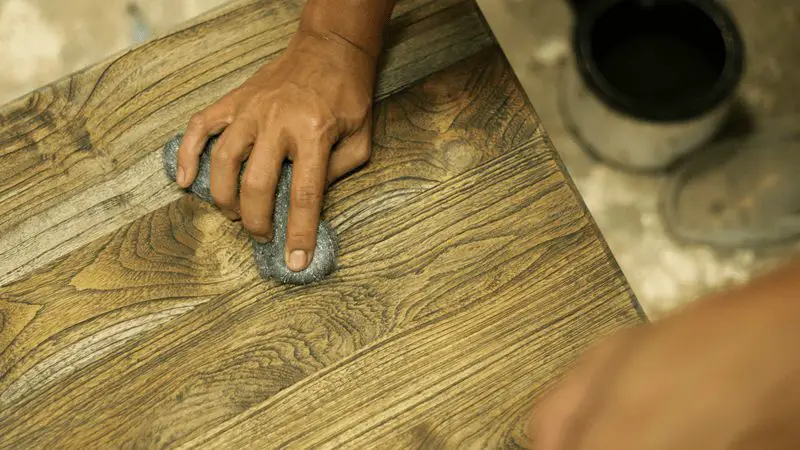Removing paint from wood while preserving the underlying finish can be challenging. The key is using the right paint remover and techniques for your specific situation. With some care and effort, you can strip paint down to reveal beautiful wood grain without harming the finish.
Page Contents
What Type of Paint Needs to be Removed?
The first step is identifying the type of paint that needs to be taken off. There are three main categories of paint:
- Oil-based paints – Also called alkyd paints, these contain solvents and dry slowly with a hard finish. They may feel slick or sticky to the touch.
- Latex paints – Made with acrylic or vinyl resins suspended in water, these paints dry faster with a matte finish. Latex feels chalky when dry.
- Enamels – Usually oil-based with a high gloss finish, these are often used on trim and metal surfaces.
It’s important to know what kind of paint coating you’re dealing with because it affects the choice of remover. Oil-based paints generally require stronger chemical strippers while latex paint can usually be removed with milder solutions.
Test for Lead Paint
If your wood surfaces are coated in old paint that could potentially contain lead, it’s critical to test for it before starting any removal process. Lead exposure can cause serious health issues, especially in children.
You can use a lead testing kit purchased from a hardware store to check paint samples from the surface. If lead is detected, take precautions to avoid creating dust and properly dispose of the paint chips. Consider hiring a professional lead abatement contractor for removal.
Select the Appropriate Paint Remover
Choosing the right type of paint remover is key to removing paint effectively while protecting your wood’s finish underneath:
- Chemical strippers – Contain strong solvents like methylene chloride that work to dissolve multiple layers of paint. Use for oil-based paints.
- Caustic strippers – Made with lye or sodium hydroxide which saponifies paint layers. Effective on most paint types.
- Soy-based strippers – Contain soybeans, orange oil, and other plant materials. Less toxic for gentle paint removal.
- Citrus-based strippers – Made from d-limonene extracted from citrus fruits. Good option for latex paint.
Always check that the remover is safe to use on finished wood surfaces without bleaching or discoloring the stain.
Prep the Wood Surface
Proper preparation is vital for getting good paint removal results. Here are some tips:
- Remove hardware like knobs or handles to give you better access.
- Lightly sand and degloss the surface to help the remover penetrate.
- Fill cracks or holes with wood filler to prevent the stripper from seeping underneath.
- Tape off any areas or trim you don’t want stripped.
- Cover nearby surfaces like floors or countertops.
Prepping provides the cleanest base for the remover to work on the painted layers.
Apply the Paint Remover
Once prepped, you’re ready to apply the remover:
- Stir or shake the remover thoroughly before using.
- If using a chemical stripper, make sure to wear gloves, eye protection, and work in a well-ventilated area.
- Use a paintbrush, plastic applicator, or sprayer to coat on a thick, even layer of remover over the surface.
- Let the remover sit for the product-recommended time to penetrate the paint layers. This may take 15 minutes up to a few hours.
- Reapply remover to any spots that need more time to soak.
Applying remover properly ensures it works effectively across the whole surface.
Scrape Away Paint
After letting the remover sit for the directed time, the paint should bubble up and be ready to scrape off. Take these steps:
- Test if the paint can be easily scraped with a plastic putty knife or spatula.
- Starting at corners or edges, use a scraper to gently lift chipping paint away from the surface.
- Keep scraping until you reach the bare wood underneath.
- For tough spots, use a brass brush or sandpaper to scrub residue away.
- Work systematically across all areas until all paint is removed.
Scraping should be done gently to avoid gouging into the wood finish. Take your time and continually wipe away paint debris as you work.
Neutralize and Clean
It’s critical to neutralize and clean the stripped surface after finishing removal. This prevents damage to the wood:
- Wipe a chemical neutralizing solution over the surface according to product instructions.
- Thoroughly rinse the wood with clean water to get rid of residue.
- Dry the surface completely with clean rags.
- Use mineral spirits and scouring pads to remove lingering stains or residue.
- Sand lightly and vacuum up any remaining debris.
Proper cleanup leaves you with a pristine wood surface free of chemicals and buildup after stripping.
Apply a New Finish
Your final step is applying a fresh coat of finish to the bare wood if desired. Options include:
- Oil-based polyurethane for a clear glossy finish
- Water-based poly for a simpler application
- Tung oil to enhance and protect the natural wood
- Stains to change up the color
- Paint/primer and repaint if you choose to
Choose your desired finish and apply according to the product instructions. Be sure to let the new coating fully cure before use.
Conclusion
It is possible to successfully remove paint from wood while protecting the underlying finish. With the right remover, techniques, and care, you can strip surfaces down to reveal beautiful wood tones without causing damage. Just be sure to properly prep, apply, neutralize, and cleanup after using paint strippers. The extra effort goes a long way to keeping your wood’s finish intact for the long term.

